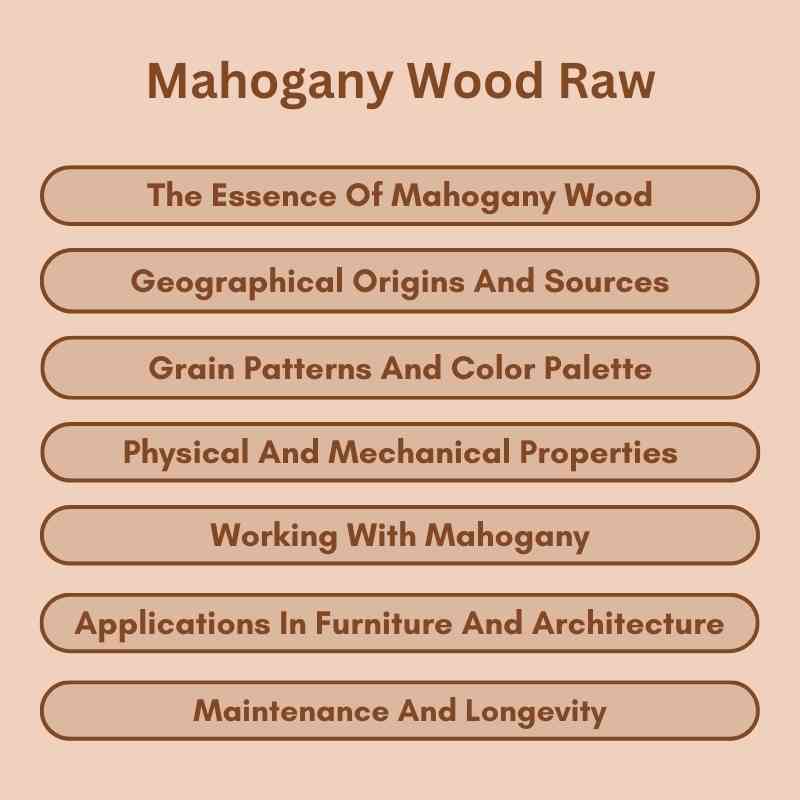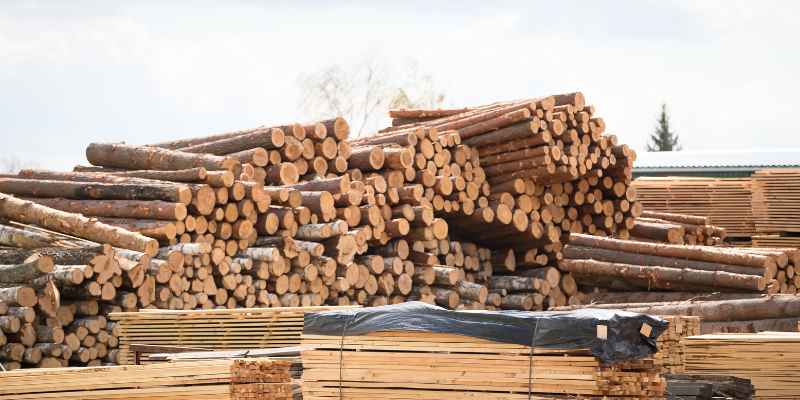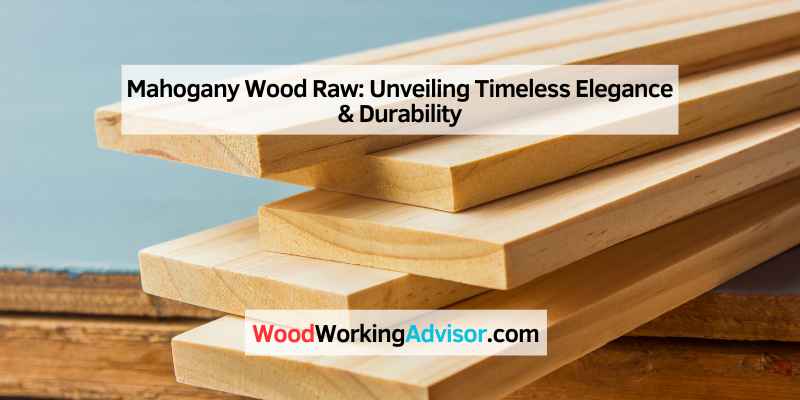Mahogany wood is a premium hardwood known for its durability and rich color. It is often used in furniture, cabinetry, and musical instruments.
Mahogany wood has long been prized for its beauty and functionality. Its deep reddish-brown hue adds warmth to any space, making it a favorite among designers and homeowners alike. This wood is sourced from several species of tropical trees, primarily found in Central and South America.
Renowned for its workability, mahogany can be easily shaped and finished, resulting in stunning pieces that stand the test of time. Beyond aesthetics, mahogany boasts excellent resistance to decay and insects, making it ideal for both indoor and outdoor applications. Understanding its qualities can help you appreciate why mahogany remains a top choice for artisans and craftsmen.
The Essence Of Mahogany Wood
Mahogany wood captures attention with its rich color and fine grain. It has been a favorite for centuries. This wood offers beauty and durability. Its deep hues and smooth texture make it ideal for furniture and decor.
Historical Significance
Mahogany has a long and storied history. It was highly prized during colonial times. Ships built from mahogany were strong and long-lasting. Craftsmen used mahogany for fine furniture and cabinetry.
- Originated in Central America
- Used by ancient civilizations
- Popular in Europe during the 18th century
- Symbol of wealth and luxury
Today, mahogany remains a symbol of quality and craftsmanship. Many artisans still choose mahogany for its heritage.
Characteristics That Stand Out
Mahogany wood boasts unique features that set it apart:
| Characteristic | Description |
|---|---|
| Color | Rich reddish-brown that deepens with age |
| Grain | Straight and fine, with a silky finish |
| Durability | Resistant to wear and decay |
| Workability | Easily cuts, shapes, and sands |
These qualities make mahogany a top choice for many projects.
Mahogany wood also has natural resistance to insects and moisture. This makes it perfect for both indoor and outdoor use.
Its beauty and strength ensure it will remain a favorite for years to come.

Geographical Origins And Sources
Mahogany wood is prized for its beauty and durability. This wood comes from specific regions around the world. Understanding its geographical origins helps in appreciating its value. Let’s explore where Mahogany is harvested and the regulations surrounding it.
Primary Locations Of Harvest
Mahogany is primarily sourced from tropical forests. Here are the main locations:
- Central America: Countries like Honduras and Guatemala.
- South America: Notably from Brazil and Peru.
- Caribbean: Islands like Cuba and Jamaica.
These regions provide the ideal climate for Mahogany trees to thrive. The rich soil and warm temperatures contribute to their growth.
Sustainability And Trade Regulations
Mahogany wood faces strict trade regulations. Many countries aim to protect their forests. Here are key points about sustainability:
- CITES: The Convention on International Trade in Endangered Species.
- Forest Stewardship Council (FSC): Ensures responsible forestry practices.
- Reforestation: Many countries promote planting new trees.
These measures help ensure Mahogany remains available for future generations. Sustainable practices benefit both the environment and local communities.
| Region | Key Regulations |
|---|---|
| Central America | Strict logging permits and conservation laws |
| South America | Protected areas and sustainable logging practices |
| Caribbean | Reforestation initiatives and trade monitoring |
Grain Patterns And Color Palette
Mahogany wood is renowned for its stunning grain patterns and rich colors. These characteristics make it a popular choice in furniture and décor. Understanding its natural beauty helps in choosing the right pieces for any space.
Natural Hues And Variations
Mahogany wood features a unique color palette. The hues range from deep reddish-brown to lighter shades. Here are some key points about its natural hues:
- Rich Reddish-Brown: The most common hue.
- Golden Undertones: Adds warmth to the wood.
- Color Variations: Can differ based on the tree and region.
These variations enhance the beauty of each piece. No two mahogany items look exactly alike.
Influence On Aesthetics And Design
Mahogany’s grain patterns and colors greatly influence design choices. Its natural beauty complements various styles.
| Style | Effect |
|---|---|
| Traditional | Creates a warm, inviting atmosphere. |
| Modern | Adds elegance and sophistication. |
| Rustic | Enhances natural charm and coziness. |
Mahogany’s unique grain patterns also catch the eye. They add texture and depth to furniture. Its luxurious appearance makes it a favorite among designers.
Physical And Mechanical Properties
Mahogany wood is known for its stunning beauty and strength. It has unique physical and mechanical properties. These features make it ideal for various applications. From furniture to musical instruments, mahogany stands out.
Durability And Strength Factors
Mahogany wood boasts excellent durability. Its natural oils help resist decay. This wood can last many years with proper care. Below are some key strength factors:
- Compression Strength: High resistance against crushing forces.
- Bending Strength: Excellent resistance to bending and warping.
- Tensile Strength: Strong resistance to pulling forces.
| Property | Value |
|---|---|
| Density | 600 – 750 kg/m³ |
| Modulus of Elasticity | 10,000 – 14,000 MPA |
| Impact Strength | Moderate to high |
Resistance To Environmental Stressors
Mahogany wood shows great resistance to various stressors. It withstands temperature changes and humidity well. This makes it ideal for indoor and outdoor use. Here are some environmental benefits:
- Insect Resistance: Natural oils repel pests.
- Mold Resistance: Less likely to develop mold.
- Water Resistance: Good for areas with high moisture.
With these properties, mahogany wood remains a top choice for many projects. Its durability ensures a long-lasting investment.
Working With Mahogany
Mahogany wood is known for its beauty and durability. Craftsmen love its rich color and smooth grain. Working with this wood requires specific techniques to achieve great results.
Machining And Crafting Techniques
Mahogany is easy to machine. It cuts and shapes well, making it ideal for various projects. Here are some effective techniques:
- Use sharp tools: Dull blades can cause splintering.
- Maintain steady pressure: Apply even pressure while cutting.
- Consider grain direction: Always cut with the grain to avoid tear-out.
For joinery, try these methods:
- Dowel joints: Perfect for strong connections.
- Mortise and tenon: Provides excellent strength and stability.
- Box joints: Great for aesthetic appeal and durability.
Finishing And Treatment Best Practices
Finishing enhances the natural beauty of mahogany. Follow these best practices for a stunning look:
| Step | Action |
|---|---|
| 1 | Sanding: Start with 120-grit sandpaper. Gradually move to 220-grit. |
| 2 | Cleaning: Remove dust with a damp cloth. |
| 3 | Staining: Use oil-based stains for rich color. |
| 4 | Sealing: Apply polyurethane for protection. |
Regular maintenance keeps mahogany looking great. Use these tips:
- Clean regularly: Use a soft, damp cloth.
- Avoid direct sunlight: Prevent fading and discoloration.
- Reapply finish: Every few years, refresh the protective layer.
Applications In Furniture And Architecture
Mahogany wood is renowned for its beauty and strength. It is a favorite among craftsmen. This wood is used in creating both luxurious furniture and stunning architectural elements. Let’s explore its applications in these two areas.
Luxury Furniture Creations
Mahogany wood creates luxury furniture that stands out. Its rich color and grain add elegance to any space. Here are some common furniture pieces made from mahogany:
- Dining tables
- Chairs
- Cabinets
- Dressers
- Bed frames
Craftsmen prefer mahogany for its workability. It is easy to carve and polish. This wood also resists scratches and dents. Many luxury brands use mahogany to enhance their collections.
Architectural Marvels And Accents
Mahogany wood plays a vital role in architecture. Its durability makes it ideal for various structures. Here are some architectural features often made from mahogany:
- Door frames
- Window frames
- Paneling
- Staircases
- Railings
Architects appreciate mahogany for its natural beauty. It adds warmth and charm to buildings. Many historic homes showcase mahogany accents. This wood is a symbol of luxury and craftsmanship.
Overall, the applications of mahogany wood highlight its versatility. From furniture to architecture, it transforms spaces beautifully.
Maintenance And Longevity
Mahogany wood is known for its beauty and durability. Proper maintenance ensures its longevity. Regular care keeps this wood looking stunning for years.
Preservation Tips For Owners
- Clean Regularly: Use a soft, damp cloth. Avoid harsh chemicals.
- Use a Wood Conditioner: Apply every six months. This helps to nourish the wood.
- Keep Away from Direct Sunlight: Sunlight can fade the rich color. Use curtains or blinds.
- Control Humidity: Mahogany prefers a stable environment. Use a humidifier in dry conditions.
- Avoid Extreme Temperatures: Keep away from heaters and air conditioners. These can cause warping.
Restoration And Repair Advice
Even with care, mahogany may need restoration over time. Follow these steps for effective repair:
- Assess Damage: Check for scratches or dents.
- Sand Lightly: Use fine-grit sandpaper. Sand in the direction of the grain.
- Apply Wood Filler: Use a matching color filler for deep scratches.
- Refinish the Surface: Use a quality varnish or oil. This adds a protective layer.
- Polish the Wood: Use a soft cloth. This enhances the shine.
| Maintenance Task | Frequency | Tips |
|---|---|---|
| Cleaning | Weekly | Use a damp cloth, avoid chemicals |
| Conditioning | Every 6 months | Nourish the wood |
| Polishing | Monthly | Enhance shine with a soft cloth |
The Cost Of Elegance
Mahogany wood symbolizes luxury and sophistication. Its rich color and fine grain attract many buyers. Yet, the price tag often raises questions. Understanding the cost of mahogany is essential for making informed decisions.
Pricing Factors And Affordability
Several factors affect the price of mahogany wood:
- Quality: Higher grades cost more.
- Source: Different regions have different prices.
- Availability: Limited supply can drive up costs.
- Size: Larger pieces are more expensive.
| Quality Grade | Price per Board Foot |
|---|---|
| FAS (First and Seconds) | $8 – $15 |
| SEI & BTR (Select and Better) | $6 – $12 |
| Common Grades | $4 – $8 |
Affordability varies by budget. Buyers should evaluate their needs and preferences.
Investment Value Over Time
Mahogany wood appreciates in value. This makes it a smart investment. Some benefits include:
- Durability: Mahogany lasts for years.
- Timeless Appeal: Its beauty never fades.
- Market Demand: Rare woods often increase in price.
Investing in mahogany can yield long-term rewards. Quality pieces can become family heirlooms. Their value may rise, making them a wise choice.
Ethical Considerations And Alternatives
Mahogany wood is beautiful and durable. It has gained popularity in furniture and decor. However, its extraction raises serious ethical issues. Understanding these issues helps consumers make informed choices.
Environmental Impact And Ethics
The demand for mahogany wood has led to significant deforestation. This impacts wildlife and contributes to climate change. Here are key points about its environmental impact:
- Deforestation: Large areas of forests are cleared.
- Biodiversity Loss: Many species lose their habitats.
- Carbon Emission: Trees absorb carbon; cutting them increases emissions.
- Illegal Logging: Unsustainable practices harm ecosystems.
Ethical sourcing of mahogany is crucial. Support companies that follow sustainable practices. Look for certifications like FSC (Forest Stewardship Council).
Sustainable Alternatives And Innovations
Many alternatives exist that are eco-friendly and sustainable. Consider these options:
- Bamboo: Fast-growing and renewable.
- Reclaimed Wood: Repurposed wood reduces waste.
- Engineered Wood: Made from smaller wood pieces, it’s strong and sustainable.
- Composite Materials: Made from recycled plastics and wood fibers.
Innovations in wood production are growing. Companies use technology to create alternatives that mimic mahogany’s beauty. Support brands committed to sustainability.
| Material | Benefits | Considerations |
|---|---|---|
| Bamboo | Fast growth, renewable | May lack traditional wood look |
| Reclaimed Wood | Unique character, eco-friendly | Limited supply, costs vary |
| Engineered Wood | Stable, less waste | May contain adhesives |
| Composite Materials | Durable, weather-resistant | Not biodegradable |

Frequently Asked Questions
What Is Mahogany Wood Used For?
Mahogany wood is prized for its durability and beauty. It’s commonly used in furniture, cabinetry, and flooring. Its rich color and fine grain make it a popular choice for high-end wood products. Additionally, Mahogany is often used in boat building due to its resistance to water and decay.
How Durable Is Mahogany Wood?
Mahogany wood is highly durable and resistant to wear. Its natural oils help protect it from moisture and pests. This makes it an excellent choice for both indoor and outdoor applications. With proper care, Mahogany can last for generations, maintaining its beauty and structural integrity over time.
Where Does Mahogany Wood Come From?
Mahogany wood primarily comes from tropical regions, especially Central and South America. The most famous species is Swietenia macrophylla, known for its rich color and quality. Sustainable harvesting practices are crucial to protect these forests. Responsible sourcing helps ensure the longevity of Mahogany’s availability in the market.
Is Mahogany Wood Expensive?
Yes, Mahogany wood is generally considered expensive. Its high price is due to its rarity, quality, and demand. The slow growth of Mahogany trees contributes to their limited supply. However, its durability and aesthetic appeal often justify the investment for many homeowners and craftsmen.
Conclusion
Mahogany wood is a remarkable choice for both aesthetics and durability. Its rich color and fine grain enhance any project. From furniture to cabinetry, its versatility stands out. Choose mahogany for a timeless look that lasts. Invest in quality wood to elevate your space and enjoy its beauty for years to come.

